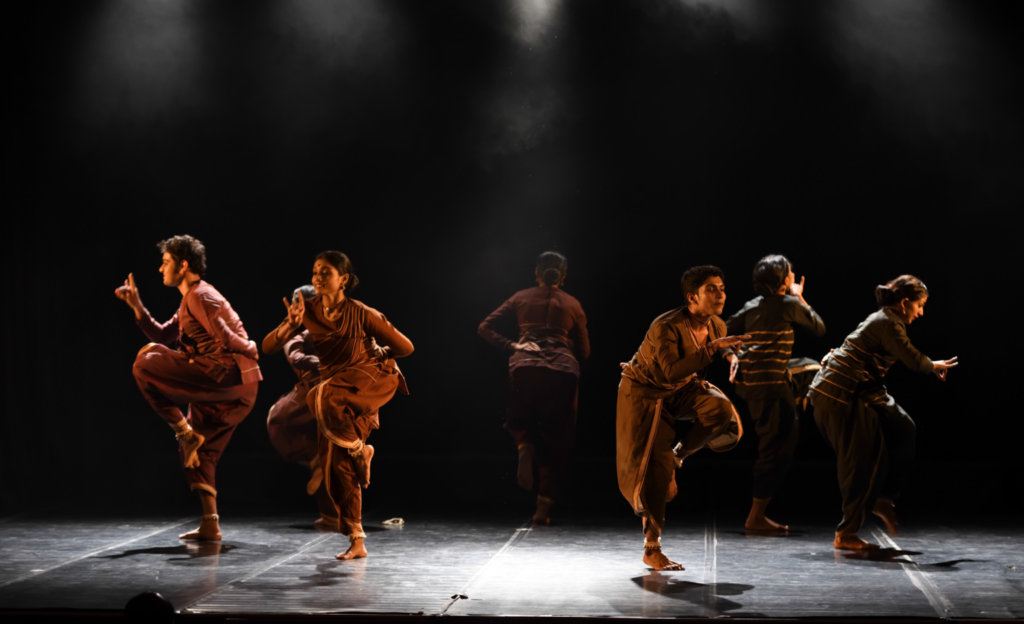By Katherine C. Zubko, University of North Carolina Asheville “How does Agathi add to the history of performing on social themes? Let’s take a closer look at a few segments within one of the most poignant scenes in Agathi, a group dance production rendered in bharatanatyam I will refer to as the ‘boat scene.’ This boat scene is both rooted in recognizable bharatanatyam frameworks, as well as utilizes that familiarity to provide a bridge to expanding attention to difficult human experiences not typically seen in the dance form. The ‘potential of the arts to move our hearts and not just our minds,’ as one London audience member noted, allows Agathi to work towards defeating the asuras of apathy when it comes to this ongoing global refugee crisis. Read more on what Katherine C Zubko says about Agathi I Refugee experience. Bharatanatyam dancers spend most of their stage time inhabiting the movements of Hindu gods and their devotees, attending to the emotional subtleties of devotional relationships, as well as their powers of intervention. At any given moment, the focus may be on Yashoda’s affection for the often mischievous Krishna as a child or his later turbulent love relationship with Radha, while the next may reenact Shiva’s powerful cosmic tandava dance of creation and destruction, Durga’s heroic intervention in killing the buffalo demon, or Vishnu taking the form of any of his avatars to restore dharma, or righteousness to the world, all acts that demonstrate godly investment in cycles of worldly and human well being. The range of emotions is intended to reflect human and divine experience in depth. While bharatnatyam dancers have explored many other narrative and thematic threads outside of Hindu mythology, very few have employed the underlying techniques of movement, rhythm and rasa to the very contemporary realities of immigration and refugee experiences with performative and aesthetic integrity. During this past 2017-18 dance festival season in Chennai, Apsaras Arts’ production of Agathi: The Plight of the Refugees, caught my attention precisely because of its cutting edge contemporary topic performed during one of the most traditional, classical arts festivals, but also its efficacious use of ensemble choreography to deliver a powerful social message. As a dance anthropologist and scholar of bharatanatyam, I am particularly interested in what is created and experienced by dancers and audiences when embodied gestures and emotion transfers into unexpected contexts. What embodied expectations and resonances frame the possibilities for creative engagement, where do adaptations occur, how successful are they, and what effects does this have on the dynamic, evolving dance form and the dancers that embody it. My current quest examines how bharatanatyam dancers choreograph and perform on contemporary social issues, and Agathi will be the focus of one of the chapters of the book. Productions on social issues are nothing new within the history of dancers trained in the classical style of bharatanatyam. Mrnalini Sarabhai and her daughter Mallika, Chandralekha, Anita Ratnam, and Ananya Chatterjea have classical training, but each shifted into more multimedia, mixed-form or contemporary iterations of their own designs related to the treatment and experiences of women, environmental devastation and other topics. Other dancers have stuck closer to their classical techniques, including foundational mythological references as part of social commentary, such as Malavika Sarukkai’s production on Ganga, Leela Samson’s Nadi, and the Narasimhacharis’ Karuna Shakti. While artists engage in different levels of artistic license and activist commitments, the underlying reasons for such endeavors range from affirmations of the educational purpose of dance by the god Brahma found within the Natyasastra (1:108-116) to dancers’ feminist, social or ecological concerns. How does Agathi add to this history of performing on social themes? Let’s take a closer look at a few segments within one of the most poignant scenes in Agathi, a group dance production mostly rendered in bharatanatyam I will refer to as the “boat scene.”


After performing a handful of vignettes that provide a window into some of the reasons people flee their homelands, from earthquakes and tsunamis, to fires and political violence, the stage goes dark except for a central spotlight. The urgent rhythm of the dancers’ feet underlie each individual emerging into the spotlight, depicting some component of fear in their lives, whether it is witnessing the horrors of human tragedy to others or being subject to harassment themselves. As the group comes together communally in a single line, they begin to call out for help, waving their hands, while also shielding themselves to the onslaught. There is a constant rhythm and rocking motion to this choreography, imitating the instability of the ground under their feet due to their circumstances, and foreshadowing the rocking of the boat they now call out to with their hands. Jumping into the boat one by one, the dancers hold onto the sides, some feeling sick, others crossing their arms over themselves with wide-open eyes, and one mother holding a baby trying to steady herself and anxiously trying to calm the child. All but the mother rise and clasp hands, morphing into the oblong shape of the boat surrounding the mother and child. Rocking, leaning, tilting high on one side and then the other, the people-boat navigates the rough waters. Hands unclasped, the boat turns back into individual people, being tossed around as the dancers roll into each other on the ground, eventually showing distinct moments of sickness, fear and anxiety. As I want to refrain from giving away the climactic moments of this scene, let me stop this description and discuss some analytical points. Without any lyrics, the experience of the refugees relies on mood, rhythm and embodied storytelling. First, the use of rhythm produced communally, in the midst of individual experiences of terrified people, points to a more universalized problem – while each refugee is experiencing their particular context, the tragedy is a more globalized human problem. Accompanying this intense thisra (3 beat) rhythm, is a second focus point created through the facial expressions, gestures and postures that evoke the rasa, or aesthetic mood, of fear in various iterations – some with their torsos caved in and protective, others waving and pushing others away, exhibiting wide-eyed disbelief, or holding their head and wailing, and shaking it side to side to indicate ‘no’. The depth of the dancers’ portrayals is accredited to the intentional process work of exposing the dancers to immigrant experiences and the poetry of refugee children in order to ‘investigate and understand the body language of a refugee’ (UK program notes, 4). While fear remains steadily portrayed throughout the scene, it is punctuated by the protective love of the mother for her child (vatsalya bhakti rasa), and compassionate response (karuna rasa) of a few others towards the mother’s panic, a response that remains brief in that other dangers quickly arise. The focus on a mother and child evokes potential resonances of Yashoda and Krishna, the primary model familiar to bharatnatyam audiences, which makes the events that unfold even more jolting due to these affectionate associations juxtaposed with the unusual depiction of a rarely staged event for a character that follows in the climax. While this production is based on the very personal experience of the artistic director, Aravinth Kumarsamy, who fled Sri Lanka during its civil war as a refugee, the intentional blending of individual and communal aspects illuminates the more universalized emotions that the aesthetic theory of rasa aims to portray. As a final third point, it is common for bharatantyam dancers, especially in the solo format, to switch perspectives, oscillating between divine and human interactive responses, as part of layering allied narratives, or sanchari bhavas. In this boat scene, it is the group that switches between being people, being the boat, and at times the motions of the tossing people also being like the turbulent waves. This technique facilitates the ability to see things from multiple perspectives. In Agathi, the director and choreographers have transferred a solo technique onto a group to increase the potential for developing an empathetic relationship to the refugees being embodied. As Kumarasamy notes, ‘The dancers do not have first hand experience [of being refugees]. The process was to try to work from the inside, from emotions. In our context of the Natyasastra, we tried to get to the sattvika abhinaya so that the angika abhinaya would come’ (interview, 10 June 2018). In this way, sattvika bhavas, such as horripilation, turning pale and fainting, trembling, tears, and other involuntary physical responses that arise from intense emotional states, were transformed through their communally interactive physical gestures and facial expressions of angika abhinaya so that audiences ‘would be able to experience the psyche of a refugee…and encourage an inclusive community for refugees seeking shelter’ (UK program notes, 4). This boat scene is both rooted in recognizable bharatanatyam frameworks, as well as utilizes that familiarity to provide a bridge to expanding attention to difficult human experiences not typically seen in the dance form. The embodied storytellers of Agathi have created a powerful new ‘Churning of the Ocean’ that depicts a very real battle for ongoing life for themselves and their children against impending death, a type of generational immortality. The ‘potential of the arts to move our hearts and not just our minds,’ as one London audience member noted, allows Agathi to work towards defeating the asuras of apathy when it comes to this ongoing global refugee crisis.









